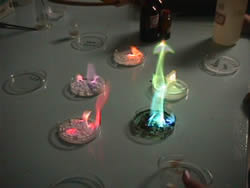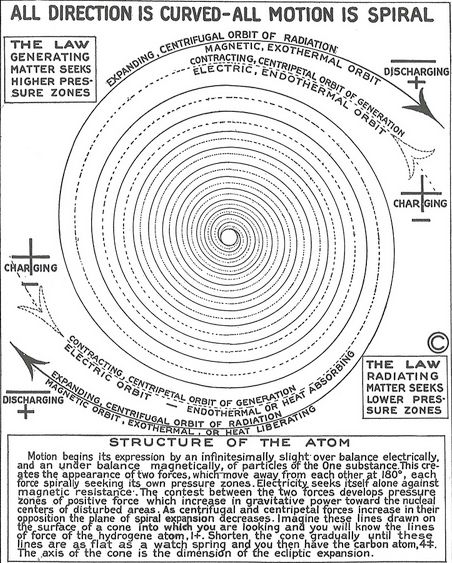It looks like you're using an Ad Blocker.
Please white-list or disable AboveTopSecret.com in your ad-blocking tool.
Thank you.
Some features of ATS will be disabled while you continue to use an ad-blocker.
share:
a reply to: MarsKingAQuestion
Frequency is not a thing.
Frequency is a property of various things; electromagnetic radiation, sound, pogo sticks.
Is frequency radiation?
Frequency is not a thing.
Frequency is a property of various things; electromagnetic radiation, sound, pogo sticks.
a reply to: eriktheawful
Starred!
Could it be a White hole
Starred!
Could it be a White hole
In general relativity, a white hole is a hypothetical region of spacetime which cannot be entered from the outside, although matter and light can escape from it. In this sense, it is the reverse of a black hole, which can only be entered from the outside, from which nothing, including light, can escape. White holes appear in the theory of eternal black holes. In addition to a black hole region in the future, such a solution of the Einstein field equations has a white hole region in its past. However, this region does not exist for black holes that have formed through gravitational collapse, nor are there any known physical processes through which a white hole could be formed.
a reply to: Phage
Starred!
I agree, therefor since only sub atomic particles, electrons, protons, neutrons and photons are emitted and the frequency is a sideline to the issue of WHAT was radiated away.
There is a serious semantic issue at play here in this area of scientific technical jargon.
We can't say UV radiation ... because UV is a frequency!
However, we can say it was EM radiation aka a wave-particle photon packet with the ionizing effect of UV frequency.
Thanks.
Starred!
I agree, therefor since only sub atomic particles, electrons, protons, neutrons and photons are emitted and the frequency is a sideline to the issue of WHAT was radiated away.
There is a serious semantic issue at play here in this area of scientific technical jargon.
We can't say UV radiation ... because UV is a frequency!
However, we can say it was EM radiation aka a wave-particle photon packet with the ionizing effect of UV frequency.
Thanks.
a reply to: MarsKingAQuestion
Yes, we can.
Because people with even a minimal understanding will know what it means.
We can't say UV radiation
Yes, we can.
Because people with even a minimal understanding will know what it means.
originally posted by: MarsKingAQuestion
a reply to: Phage
Starred!
I agree, therefor since only sub atomic particles, electrons, protons, neutrons and photons are emitted and the frequency is a sideline to the issue of WHAT was radiated away.
There is a serious semantic issue at play here in this area of scientific technical jargon.
We can't say UV radiation ... because UV is a frequency!
However, we can say it was EM radiation aka a wave-particle photon packet with the ionizing effect of UV frequency.
Thanks.
I'm confused.

edit on 20-11-2014 by eisegesis because: (no reason given)
I like the idea of something radiating coming our way, maybe decelerating.
But that would result in a change of wavelengths, according to Doppler effects. Doesn't seem to be happening.
The idea of an up-powering laser directed at us is a nice one, too!
And @protectors: yeah, we are dead. We don't have enough antimatter for defense..
But that would result in a change of wavelengths, according to Doppler effects. Doesn't seem to be happening.
The idea of an up-powering laser directed at us is a nice one, too!
And @protectors: yeah, we are dead. We don't have enough antimatter for defense..
a reply to: eisegesis
Basically, there has been a habit amongst some people to refer to things by using the word frequency, rather than to describe them specifically using more accurate terminology. Despite the fact that things in the universe have frequencies associated with them, one cannot describe these things using the word frequency alone, because to do so is missing the point.
Imagine you are in a car lot, and all the cars around you are super cars, with similar horsepower output and torque capacity. To be accurate, you will look at them and say, "oh, look, there is a Porsche, and here is a Ferrari!", because those are names we all know, and we know that if we look into the subject more, if we ask you what make and model they are, we get better information. That information may INCLUDE the bhp rating and the torque capacity, but it will also include other helpful data, identifying the vehicles involved with specific information.
In the same way, one cannot refer to a thing by its frequency alone, because to do so clouds the issue and confuses everything. As a manner of communication therefore, it fails!
Basically, there has been a habit amongst some people to refer to things by using the word frequency, rather than to describe them specifically using more accurate terminology. Despite the fact that things in the universe have frequencies associated with them, one cannot describe these things using the word frequency alone, because to do so is missing the point.
Imagine you are in a car lot, and all the cars around you are super cars, with similar horsepower output and torque capacity. To be accurate, you will look at them and say, "oh, look, there is a Porsche, and here is a Ferrari!", because those are names we all know, and we know that if we look into the subject more, if we ask you what make and model they are, we get better information. That information may INCLUDE the bhp rating and the torque capacity, but it will also include other helpful data, identifying the vehicles involved with specific information.
In the same way, one cannot refer to a thing by its frequency alone, because to do so clouds the issue and confuses everything. As a manner of communication therefore, it fails!
edit on 20-11-2014 by TrueBrit because: Grammar edit
originally posted by: Phage
a reply to: eisegesis
Maybe it's an alien laser cannon someone shot at us and every year it gets closer. That would explain why it gets brighter.
You read Protector, didn't you?
Actually, it's pulses from a Bussard ramjet. The spacecraft has performed turnover and is shedding velocity by directing it's thrust toward Earth.
AWWW.......N Space, one of the best universes ever imagined! Though the puppeteers and the PAK Protectors are genius,the Tzinti and ring world are my 2 favorite story lines.
Damn i got to go, it is time to head back to ARM for my schitz meds.
a reply to: MarsKingAQuestion
Frequency is a measurement of something.
Ultra violet electromagnetic energy is part of a thing.
TrueBrit gave a good analog of that: You have a group of things called "Cars", you can break the group down by manufactures: Ford, Dodge, Toyota, Kia, etc, etc.
Then you can break it down further by type of car: Ford SUV. Then even further: Ford, SUV, Explorer.
Electromagnetic energy is the same way: It's energy with both electrical and magnetic properties that oscillates at certain frequencies, and can be broken down into different spectrums:
Vhf, Uhf, Visible light, Infrared, Ultraviolet, X-Ray, Gamma, etc, etc.
Frequency of those things is just a measurement to tell us where it is in the EM spectrum. If I measure some electromagnetic energy and find it has a frequency of 999,308 Ghz that places it in the UV part of the Spectrum (and means it has a wave length of 300 nm). If I were to measure another source, and it's frequency is 102.3 Mhz, it's a radio wave (the frequency of my favorite classic rock station), and is part of what we call the FM bandwidth.
Radiation is, in this case, is what the EM does. We call it radiation because it radiates out from it's source (or propagates from it's source). A light bulb in your room is radiating visible light.
Yes, radiation can be a "thing" too, but normally we refer to it as a thing when we're talking about nuclear radiation and not so much EM radiation.
Frequency is a measurement of something.
Ultra violet electromagnetic energy is part of a thing.
TrueBrit gave a good analog of that: You have a group of things called "Cars", you can break the group down by manufactures: Ford, Dodge, Toyota, Kia, etc, etc.
Then you can break it down further by type of car: Ford SUV. Then even further: Ford, SUV, Explorer.
Electromagnetic energy is the same way: It's energy with both electrical and magnetic properties that oscillates at certain frequencies, and can be broken down into different spectrums:
Vhf, Uhf, Visible light, Infrared, Ultraviolet, X-Ray, Gamma, etc, etc.
Frequency of those things is just a measurement to tell us where it is in the EM spectrum. If I measure some electromagnetic energy and find it has a frequency of 999,308 Ghz that places it in the UV part of the Spectrum (and means it has a wave length of 300 nm). If I were to measure another source, and it's frequency is 102.3 Mhz, it's a radio wave (the frequency of my favorite classic rock station), and is part of what we call the FM bandwidth.
Radiation is, in this case, is what the EM does. We call it radiation because it radiates out from it's source (or propagates from it's source). A light bulb in your room is radiating visible light.
Yes, radiation can be a "thing" too, but normally we refer to it as a thing when we're talking about nuclear radiation and not so much EM radiation.
a reply to: TrueBrit
Aw, I wanted MarsKingAQuestion to explain him/herself. I was having some fun. I am aware of what the poster was trying to say, but my brain turned into a pretzel when I read the post. Thanks for your explanation though. One of my idols is Walter Russell who I stumbled upon at an early age. Whether all his theories are correct or not, his work completely changed my view of the world. At times it's hard to talk about the standard models when my approach always comes in from left field.
Here, I'll share a little.
Because each element has an exactly defined line emission spectrum, scientists are able to identify them by the color (frequency) of flame they produce.

copper (atomic mass 63.5) produces a blue flame
calcium (Atomic mass: 40.078) an orange flame
sodium (Atomic mass: 22.989769) a yellow flame
barium (Atomic mass: 137.327) a green flame
lithium (Atomic mass: 6.941) and strontium (Atomic mass: 87.62) a red flame
cesium (Atomic Mass 132.9054) a violet flame
Indium (Atomic Mass 114.82) a blue flame
molybdenum (Atomic Mass 95.94) a green flame
This is my periodic table of elements, all based on frequency.



This is what it's like when worlds collide...

I've been wanting to do a thread on all of this to see what members reactions would be. I might learn something in the process.
Thank god for info graphics. This one never gets old! It should be hanging in every nerds bedroom or office.

Aw, I wanted MarsKingAQuestion to explain him/herself. I was having some fun. I am aware of what the poster was trying to say, but my brain turned into a pretzel when I read the post. Thanks for your explanation though. One of my idols is Walter Russell who I stumbled upon at an early age. Whether all his theories are correct or not, his work completely changed my view of the world. At times it's hard to talk about the standard models when my approach always comes in from left field.
Here, I'll share a little.
Because each element has an exactly defined line emission spectrum, scientists are able to identify them by the color (frequency) of flame they produce.

copper (atomic mass 63.5) produces a blue flame
calcium (Atomic mass: 40.078) an orange flame
sodium (Atomic mass: 22.989769) a yellow flame
barium (Atomic mass: 137.327) a green flame
lithium (Atomic mass: 6.941) and strontium (Atomic mass: 87.62) a red flame
cesium (Atomic Mass 132.9054) a violet flame
Indium (Atomic Mass 114.82) a blue flame
molybdenum (Atomic Mass 95.94) a green flame
This is my periodic table of elements, all based on frequency.



This is what it's like when worlds collide...

I've been wanting to do a thread on all of this to see what members reactions would be. I might learn something in the process.
Thank god for info graphics. This one never gets old! It should be hanging in every nerds bedroom or office.

edit on 20-11-2014 by eisegesis because: (no reason given)
a reply to: maryhinge
Thanks. It never pays off to be stuck in one gear. You have to shift sometimes to get the results you're looking for. Ever try to drive to work in only second gear? Those who can learn to shift will always get to their destination faster, whatever that may be!
In the end your still driving the same car and we will all get there eventually. Metaphorically speaking, when people don't have the means of transportation, they tend to carpool. Whether they forever hitch a ride on an idea or go it alone is what make science so interesting.
Thanks. It never pays off to be stuck in one gear. You have to shift sometimes to get the results you're looking for. Ever try to drive to work in only second gear? Those who can learn to shift will always get to their destination faster, whatever that may be!
In the end your still driving the same car and we will all get there eventually. Metaphorically speaking, when people don't have the means of transportation, they tend to carpool. Whether they forever hitch a ride on an idea or go it alone is what make science so interesting.
raises hand...
i understand gold is the last metal produced by a star/nuclear reactor? ...watch it be iron...
supposing unknown-extra-nuclear-reactions following super-nova occurring during the formation of 'new' precious metal?
is it a new kind of spacedust we are seeing?
that bit about it hurtling toward Earth gives me the science channel logo's heebee geebeez.
gravitational forces sucking a planets atmoshere...picture
i understand gold is the last metal produced by a star/nuclear reactor? ...watch it be iron...
supposing unknown-extra-nuclear-reactions following super-nova occurring during the formation of 'new' precious metal?
is it a new kind of spacedust we are seeing?
that bit about it hurtling toward Earth gives me the science channel logo's heebee geebeez.
gravitational forces sucking a planets atmoshere...picture
new topics
-
Big Storms
Fragile Earth: 17 minutes ago -
Where should Trump hold his next rally
2024 Elections: 3 hours ago -
Shocking Number of Voters are Open to Committing Election Fraud
US Political Madness: 3 hours ago -
Gov Kristi Noem Shot and Killed "Less Than Worthless Dog" and a 'Smelly Goat
2024 Elections: 4 hours ago -
Falkville Robot-Man
Aliens and UFOs: 4 hours ago -
James O’Keefe: I have evidence that exposes the CIA, and it’s on camera.
Whistle Blowers and Leaked Documents: 5 hours ago -
Australian PM says the quiet part out loud - "free speech is a threat to democratic dicourse"...?!
New World Order: 6 hours ago -
Ireland VS Globalists
Social Issues and Civil Unrest: 6 hours ago -
Biden "Happy To Debate Trump"
2024 Elections: 7 hours ago -
RAAF airbase in Roswell, New Mexico is on fire
Aliens and UFOs: 7 hours ago
top topics
-
A Warning to America: 25 Ways the US is Being Destroyed
New World Order: 17 hours ago, 21 flags -
Blast from the past: ATS Review Podcast, 2006: With All Three Amigos
Member PODcasts: 9 hours ago, 13 flags -
James O’Keefe: I have evidence that exposes the CIA, and it’s on camera.
Whistle Blowers and Leaked Documents: 5 hours ago, 12 flags -
Australian PM says the quiet part out loud - "free speech is a threat to democratic dicourse"...?!
New World Order: 6 hours ago, 12 flags -
Biden "Happy To Debate Trump"
2024 Elections: 7 hours ago, 11 flags -
Mike Pinder The Moody Blues R.I.P.
Music: 9 hours ago, 8 flags -
What is the white pill?
Philosophy and Metaphysics: 8 hours ago, 6 flags -
Shocking Number of Voters are Open to Committing Election Fraud
US Political Madness: 3 hours ago, 5 flags -
Ireland VS Globalists
Social Issues and Civil Unrest: 6 hours ago, 5 flags -
RAAF airbase in Roswell, New Mexico is on fire
Aliens and UFOs: 7 hours ago, 5 flags
active topics
-
Big Storms
Fragile Earth • 2 • : xuenchen -
Massachusetts Drag Queen Leads Young Kids in Free Palestine Chant
Social Issues and Civil Unrest • 21 • : ToneD -
Biden "Happy To Debate Trump"
2024 Elections • 49 • : TheMisguidedAngel -
Candidate TRUMP Now Has Crazy Judge JUAN MERCHAN After Him - The Stormy Daniels Hush-Money Case.
Political Conspiracies • 816 • : xuenchen -
Where should Trump hold his next rally
2024 Elections • 13 • : Edumakated -
Shocking Number of Voters are Open to Committing Election Fraud
US Political Madness • 6 • : marg6043 -
University of Texas Instantly Shuts Down Anti Israel Protests
Education and Media • 312 • : marg6043 -
Gov Kristi Noem Shot and Killed "Less Than Worthless Dog" and a 'Smelly Goat
2024 Elections • 30 • : TheMisguidedAngel -
President BIDEN's FBI Raided Donald Trump's Florida Home for OBAMA-NORTH KOREA Documents.
Political Conspiracies • 36 • : BingoMcGoof -
ALERT - U.S. President JOE BIDEN Examined and Found NOT OF SOUND MIND.
2024 Elections • 64 • : WeMustCare
